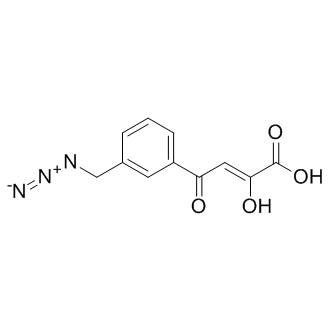
HIV-1 integrase inhibitor
CAS No. 544467-07-4
HIV-1 integrase inhibitor( —— )
Catalog No. M14954 CAS No. 544467-07-4
HIV-1 integrase inhibitor is an HIV-1 integrase inhibitor.
Purity : >98% (HPLC)
 COA
COA
 Datasheet
Datasheet
 HNMR
HNMR
 HPLC
HPLC
 MSDS
MSDS
 Handing Instructions
Handing Instructions
| Size | Price / USD | Stock | Quantity |
| 100MG | Get Quote | Get Quote |


|
| 200MG | Get Quote | Get Quote |


|
| 500MG | Get Quote | Get Quote |


|
| 1G | Get Quote | Get Quote |


|
Biological Information
-
Product NameHIV-1 integrase inhibitor
-
NoteResearch use only, not for human use.
-
Brief DescriptionHIV-1 integrase inhibitor is an HIV-1 integrase inhibitor.
-
DescriptionHIV-1 integrase inhibitor is an HIV-1 integrase inhibitor.
-
In Vitro——
-
In Vivo——
-
Synonyms——
-
PathwayMicrobiology/Virology
-
TargetHIV
-
RecptorHIV
-
Research Area——
-
Indication——
Chemical Information
-
CAS Number544467-07-4
-
Formula Weight247.2069
-
Molecular FormulaC11H9N3O4
-
Purity>98% (HPLC)
-
Solubility10 mM in DMSO
-
SMILESOC(/C(O)=C/C(C1=CC=CC(CN=[N+]=[N-])=C1)=O)=O
-
Chemical Name2-Butenoic acid, 4-[3-(azidomethyl)phenyl]-2-hydroxy-4-oxo-
Shipping & Storage Information
-
Storage(-20℃)
-
ShippingWith Ice Pack
-
Stability≥ 2 years
Reference
1. Hobaika Z, et al. Neurochem Res. 2010 Jun;35(6):888-93.
2. Kawasuji T, et al. J Med Chem. 2012 Oct 25;55(20):8735-44.
3. Loizidou EZ, et al. Bioorg Med Chem. 2009 Jul 1;17(13):4806-18.
molnova catalog



related products
-
ZBMA-1
ZBMA-1 is a potent HIV-1 replication inhibitor (IC50=1.01 uM) that efficiently protects APOBEC3G protein by targeting Vif-APOBEC3G complex.
-
Limonin
Limonin is a limonoid, and a bitter, white, crystalline substance found in citrus and other plants. It is also known as limonoate D-ring-lactone and limonoic acid di-delta-lactone.
-
PF-4776548
PF-4776548 (PF-04776548) novel HIV integrase inhibitor for treatment of HIV infections.



 Cart
Cart
 sales@molnova.com
sales@molnova.com


